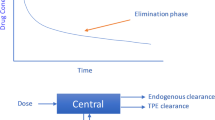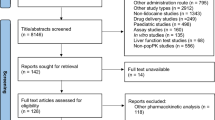Abstract
Optimizing systemic busulfan exposure, the area under the concentration–time curve (AUC), improves the outcomes for hematopoietic stem cell transplantation (HSCT). The AUC is conventionally calculated using six plasma concentrations (AUC0–∞) drawn after the first of 16 intravenous busulfan doses given as a 2-h infusion every 6 h. The aim of the present study was to develop limited sampling strategies using three or fewer busulfan concentrations to reliably calculate AUC0–∞ in patients undergoing HSCT. We investigated the pharmacokinetics of busulfan 46 times in 29 pediatric patients receiving intravenous busulfan. Limited sampling strategies using one, two, or three plasma busulfan concentrations were developed by multiple linear regression that showed excellent agreement with AUC0–∞. In single-point sampling strategies, the AUC0–∞ predicted based on C6 (trough level: busulfan plasma concentration 6 h after the start of the infusion) was significantly correlated with, and not statistically different from, actual values as follows: AUC0–∞ = 2556.5 C6 + 320.9 (r 2 = 0.929, P < 0.0001, mean bias 0.282 %, precision 7.91 %). In contrast, the predicted AUCs derived from the other sampling single points did not meet the criteria. The trough level well correlated with actual AUC0–∞, suggesting that this time-point is acceptable for busulfan monitoring.

Similar content being viewed by others
References
Hoy SM, Lyseng-Williamson KA. Intravenous busulfan in the conditioning treatment of pediatric patients prior to hematopoietic stem cell transplantation. Paediatr Drugs. 2007;9:271–8.
Bredeson C, LeRademacher J, Kato K, Dipersio JF, Agura E, Devine SM, et al. Prospective cohort study comparing intravenous busulfan to total body irradiation in hematopoietic cell transplantation. Blood. 2013;122(24):3871–8.
Slattery JT, Sanders JE, Buckner CD, Schaffer RL, Lambert KW, Langer FP, et al. Graft-rejection and toxicity following bone marrow transplantation in relation to busulfan pharmacokinetics. Bone Marrow Transplant. 1995;16:31–42.
Dix SP, Wingard JR, Mullins RE, Jerkunica I, Davidson TG, Gilmore CE, et al. Association of busulfan area under the curve with veno-occlusive disease following BMT. Bone Marrow Transplant. 1996;17:225–30.
Michel G, Valteau-Couanet D, Gentet JC, Esperou H, Socié G, Méchinaud F, et al. Weight-based strategy of dose administration in children using intravenous busulfan: clinical and pharmacokinetic results. Pediatr Blood Cancer. 2012;58(1):90–7.
Nagasawa M, Mitsuiki N, Ono T, Takagi M, Oda H, Yasuhara M, et al. Pharmacokinetic monitoring is still required for intravenous busulfan in SCT for small children. Int J Hematol. 2010;91(4):728–30.
Sato M, Kako S, Matsumoto K, Oshima K, Akahoshi Y, Nakano H, et al. Pharmacokinetics study of once-daily intravenous busulfan in conditioning regimens for hematopoietic stem cell transplantation. Int J Hematol. 2015;101(5):497–504.
Russell JA, Kangarloo SB. Therapeutic drug monitoring of busulfan in transplantation. Curr Pharm Des. 2008;14(20):1936–49.
Nguyen L, Fuller D, Lennon S, Leger F, Puozzo C. I.V. busulfan in pediatrics: a novel dosing to improve safety/efficacy for hematopoietic progenitor cell transplantation recipients. Bone Marrow Transplant. 2004;33(10):979–87.
Henner WD, Furlong EA, Flaherty MD, Shea TC, Peters WP. Measurement of busulfan in plasma by high-performance liquid chromatography. J Chromatogr. 1987;416:426–32.
Yamaoka K, Nakagawa T, Uno T. Statistical moments in pharmacokinetics. J Pharmacokinet Biopharm. 1978;6(6):547–58.
Nishikawa T, Okamoto Y, Tanabe T, Shinkoda Y, Kodama Y, Higashi M, et al. Unexpectedly high AUC levels in a child who received intravenous busulfan before stem cell transplantation. Bone Marrow Transplant. 2010;45(3):602–4.
Okamoto Y, Nagatoshi Y, Kosaka Y, Kikuchi A, Kato S, Kigasawa H, et al. Prospective pharmacokinetic study of intravenous busulfan in hematopoietic stem cell transplantation in 25 children. Pediatr Transplant. 2014;18(3):294–301.
Zao JH, Schechter T, Liu WJ, Gerges S, Gassas A, Egeler RM, et al. Performance of busulfan dosing guidelines for pediatric hematopoietic stem cell transplant conditioning. Biol Blood Marrow Transplant. 2015;21(8):1471–8.
Takamatsu Y, Sasaki N, Eto T, Nagafuji K, Abe Y, Choi I, et al. Individual dose adjustment of oral busulfan using a test dose in hematopoietic stem cell transplantation. Int J Hematol. 2007;86(3):261–8.
Beri R, Chunduri S, Sweiss K, Peace DJ, Mactal-Haaf C, Dobogai LC, et al. Reliability of a pretransplant i.v. BU test dose performed 2 weeks before myeloablative FluBu conditioning regimen. Bone Marrow Transplant. 2010;45(2):249–53.
Spasojevic I, da Costa LR, Horwitz ME, Long GD, Sullivan KM, Chute JP, et al. Mini test dose of intravenous busulfan (busulfex(®)) in allogeneic non-myeloablative stem cell transplantation, followed by liquid chromatography tandem-mass spectrometry. Cancer Invest. 2012;30(9):679–82.
Nguyen L, Leger F, Lennon S, Puozzo C. Intravenous busulfan in adults prior to haematopoietic stem cell transplantation: a population pharmacokinetic study. Cancer Chemother Pharmacol. 2006;57(2):191–8.
Dupuis LL, Sibbald C, Schechter T, Ansari M, Gassas A, Théorêt Y, et al. IV busulfan dose individualization in children undergoing hematopoietic stem cell transplant: limited sampling strategies. Biol Blood Marrow Transplant. 2008;14(5):576–82.
Xie HG, Kim RB, Wood AJ, Stein CM. Molecular basis of ethnic differences in drug disposition and response. Annu Rev Pharmacol Toxicol. 2001;41:815–50.
Acknowledgments
This work was supported in part by funds for Grant-in-Aid for Young Scientists (B) from the Ministry of Education, Culture, Sports, Science and Technology of Japan (Grant Number #26870460 to TN).
Author information
Authors and Affiliations
Corresponding author
Ethics declarations
Conflict of interest
None.
Additional information
E. Watanabe and T. Nishikawa have contributed equally to this work.
About this article
Cite this article
Watanabe, E., Nishikawa, T., Ikawa, K. et al. Trough level monitoring of intravenous busulfan to estimate the area under the plasma drug concentration–time curve in pediatric hematopoietic stem cell transplant recipients. Int J Hematol 102, 611–616 (2015). https://doi.org/10.1007/s12185-015-1853-6
Received:
Revised:
Accepted:
Published:
Issue Date:
DOI: https://doi.org/10.1007/s12185-015-1853-6




